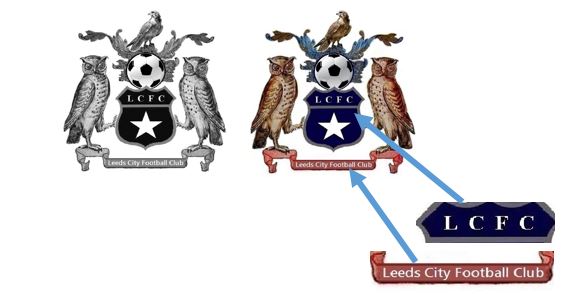03/12/2018
Brief history of Leeds City Football Club:
Leeds City Football Club was the leading professional club in Leeds before it dissolved in 1919. Leeds United was founded as a replacement in the same year, and took over the Elland Road stadium.
Another Leeds City Football Club was founded in 2006, and which now play in the Premier Division of the West Yorkshire League. Leeds City and Leeds United are separate clubs.
Opposition Proceedings:
In June 2017, Leeds City Football Club filed to register in the United Kingdom, the figurative marks as a series of two under a single application (emphasis added by us on the word elements) shown below for the following goods and services:-
Class 16: printed matter; photographs; stationary; instructional and teaching material
Class 25: clothing; footwear; headgear
Class 26: badges for wear, not or precious metal
Class 41: education; providing of training; entertainment; sporting and cultural activities

After the application was published, it was opposed by Leicester City Football Club.
Leicester relied on its rights in the word mark LCFC which it has registered in the UK since April 2001. Its registration of the mark LCFC covers a range of goods and services, the most relevant of which were selected for these opposition proceedings (classes 16, 25, 26 and 41).
Leicester based its opposition on four grounds under the Trade Marks Act 1994 (“the Act”):-
- Section 5(2)(b) – a likelihood of confusion exists as a result of the identity and/or similarity of the marks and goods and services
- Section 5(3) – use of the later mark on the goods / services would take unfair advantage of or be detrimental to the distinctive character or reputation of the earlier mark
- Section 5(4)(a) – use of the mark of the application would be contrary to the law of passing off
- Section 3(6) – the application was made in bad faith
The parties both filed evidence. Leicester’s evidence mostly related to their 2016 victory in the Premier League, including signage on the open-top buses that carried the team on their victory parade (and which was attended by more than 240,000) but also evidence showing that the mark LCFC is used on its social media platforms and on goods offered for sale on its website LCFC.com. Leicester also filed materials to support their argument that Leeds’ application was made in bad faith.
Leeds filed evidence about the history of the club and its progression through the divisions of the West Yorkshire League and an image of an older Leeds City crest that includes three owls and the letters LCFC. Leeds had no professional representative in the matter and the Hearing Officer commented in his decision that Leeds had made some errors in the required legal format and deadlines for filing of its evidence and submissions. Leeds also appeared to misunderstand the proper legal assessment of the marks and of a likelihood of confusion.
The UK Intellectual Property Office (“the UKIPO”) considered the first ground of opposition under Section 5(2)(b) of the Act which reads:
A trade mark shall not be registered if because—
(b )it is similar to an earlier trade mark and is to be registered for goods or services identical with or similar to those for which the earlier trade mark is protected,
there exists a likelihood of confusion on the part of the public, which includes the likelihood of association with the earlier trade mark.
The UKIPO held that a likelihood of confusion does exist and Leeds’ application was rejected in its entirety.
The marks are similar to the extent that Leicester’s mark LCFC is entirely contained in Leeds’ mark, and which itself “occupies a central and striking position” in the later mark.
In the case of both marks, the average consumer will recognise that the letters “FC” stand for “Football Club” and the letters “LCFC” is an acronym for a football club having the initials “LC”. As a result, the marks are conceptually similar to a medium to high degree.
Whilst Leeds’ mark contains “large and striking device elements” such as the two owls on each side of the shield device, the football located directly above the shield, and the third bird located above the football and the wording “Leeds City Football Club” written at the bottom, the UKIPO held that these elements were not enough. If anything, the heraldic elements, the football and the prominent positioning of an acronym ending “FC” will be immediately recognised by the average consumer as being the crest of a football club having the initials “LC”.
There was little to dispute on the comparison of the goods and services. Leeds’ goods and services were held to be identical or else highly similar to the goods and services of Leicester’s registration.
Whilst Leicester was successful in its claim under section 5(2)(b) and its other grounds of opposition did not need to be assessed, the Hearing Officer still addressed the claim that the application was made in bad faith because such an allegation is a serious matter and can only succeed if there is cogent evidence to that effect. The Hearing Officer concluded fairly quickly that because Leeds’ mark includes the full name ‘Leeds City Football Club’, along with the acronym ‘LCFC’ and much of Leeds city’s coat of arms, it does not appear to be a mark purporting to be that of Leicester, and is therefore quite sufficient to defeat the allegation of bad faith.
Takeaway Points
- In cases where the earlier mark is entirely contained in the later mark, the marks are likely to be held to be similar
- Even “large and striking device elements” might not be enough to sufficiently distinguish between marks, particularly if they coincide in identical word / letter elements.
- Acronyms can hold a normal degree of distinctive character, provided they do not directly refer to the goods or services at issue
- Acronyms can also be logically understood by the average consumer, as in the case here where the UKIPO concluded that the letters “FC” are understood to stand for “Football Club”
- The expense of legal representation can be extremely beneficial and worthwhile in helping a party to put its very best and strongest case forward to defend its registered or applied for rights.
[Case reference: O-755-18, dated 26 November 2018]
This article is for general information only. Its content is not a statement of the law on any subject and does not constitute advice. Please contact Reddie & Grose LLP for advice before taking any action in reliance on it.

